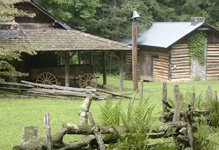 If you have ever tried to grow a few tomatoes here in metro Atlanta, then you probably know how grateful the squirrels are for the easy handout.
If you have ever tried to grow a few tomatoes here in metro Atlanta, then you probably know how grateful the squirrels are for the easy handout.
I was in denial at first. It was about six years ago that I began to notice my produce mysteriously disappearing from the vine. At first I thought–in true, scary, cranky old-lady gardener style–that some pesky neighborhood brats were sneaking onto my property and raiding my patch. Then I decided if some poor starving person (or teenager who suddenly craved my tomatoes instead of fast food) was going to all that trouble to take my vegetables, he or she needed them more than I did. I tried to make peace with it.
But then one summer morning, from my upstairs window, I saw what was really going on.
That little bastard was hanging upside down by his toes from the tomato cage, plucking a nearly-ripe fruit from the vine, taking one bite, then throwing it down on the ground. Taking another nearly-ripe fruit, one chomp, toss. No compunction whatsoever about the abundant waste, not to mention the flagrant theft. No consideration at all for the fact that I had, back in January, carefully selected those seeds from the bedazzlement that is the Totally Tomatoes catalog, nestled them in organic seed starter on top of a warming mat and under a grow lamp in February, transferred the delicate little seedlings to larger containers in March, and finally in late April moved my green toddlers out into the sunshine and prepared earth. All that work so that the evildoers could steal my fruits–every single one.

What happens to Swiss chard seedlings when they aren't inside the Squirrel-Proof Net Tent
And they didn’t stop there. Once they had wiped out the tomatoes, they moved on to the squash, cucumbers, lettuce, chard, kale (anything leafy green, really), peppers. During the summer droughts of 2006 through 2008, they would dig up entire plants and gnaw on the roots. (I placed shallow pans of water for them outside in hopes of deflecting their interest. They thanked me then went back to decimating my green bean population.)
After three or four years of watching my optimistically started spring gardens reduced to vast wastelands, it finally got to me. I would come home from work after thinking all day about the delicious pasta sauce I would make that night–or the fabulous stuffed chard leaves, or just a salad of fresh cucumber–only to find stuff half-eaten, fruits stripped off their plants, plants dug out of the ground. I’d stomp and yell and shake my fist while the squirrels sat nearby and laughed and chattered. Tears actually flowed along with the curses.
And then there was the evening I stood, bereft, under the oak tree near my kitchen patch, my eyes scanning the landscape for the giant almost-ripe mortgage lifter that had been there only hours before, when a mushy bit of its remains fell out of the tree and landed on the ground in front of me. A final, cruel insult.

My crack team of squirrel assassins
Friends and neighbors had many creative suggestions. The best idea (supplied by my dear friend the executive director of the Oakhurst Garden) was to pay the seven-year-old kid next door to sit in my yard all day with a BB gun and have at it. His unenlightened parents, however, did not see fit to take him out of school for said violation of child labor laws. Others suggested I get cats, not knowing that indeed I already have two cats, who lounge in their window bed and watch the squirrel raids for recreation between naps. If I happen to be around, they say, “Hey–look. Those squirrels are eating your garden. You really should do something about that.” Then they turn over and go back to sleep. Helpful, those guys.
I hunted around on the internet for solutions and ended up paying actual money for (hold your nose) granulated fox urine. Turns out you can get anything on the internet. I sprinkled the granules throughout and around the garden. The cats informed me that it stunk to high heaven and then turned over and went back to sleep. Caleb, my Australian shepherd, thought it was the most Exciting! Smell! Ever! And could he have a little with his dinner? The squirrels, on the other hand, didn’t even seem to notice and continued to cut their swath.
There were other ideas: dried blood spray (as effective as the granulated fox urine). Plant double everything so that there’s enough for me and the squirrels (I got double squirrels). Used cat litter (Caleb thought he’d died and gone to heaven). Human hair clippings (actually worked on direct-sewn seeds until they sprouted). My Rabun County friends had lots to say about .22s and squirrel stew (the .22s are illegal to fire in these here parts, and I haven’t adjusted to the idea of squirrel stew just yet).
 It was while watching a PBS special on Ronald Reagan and his crazily misguided Strategic Defense Initiative that it came to me: I needed to intercept the missiles before they got anywhere near the garden. To paraphrase the Great Communicator himself, I needed a program to counter the awesome squirrel threat with measures that were defensive.
It was while watching a PBS special on Ronald Reagan and his crazily misguided Strategic Defense Initiative that it came to me: I needed to intercept the missiles before they got anywhere near the garden. To paraphrase the Great Communicator himself, I needed a program to counter the awesome squirrel threat with measures that were defensive.

The Squirrel-Proof Net Tent
What I needed was an SDI for my garden.
Since I couldn’t get permitted for satellites with laser beams, I settled for a giant nylon tent made of garden netting. After pondering on it for a few months, my then-boyfriend and I hatched a plan, which we implemented last March.

Pegged and weighted down the edges
The Squirrel-Proof Net Tent is made of nylon garden netting, PVC poles secured into the ground with some short lengths of rebar, some of those plastic lock ties, and a few garden fabric pegs. To add a little prayer to my pragmatism, and to let the squirrels know I wished them no ill, I festooned the whole thing with a few strands of Tibetan prayer flags.

The center pole of the Squirrel-Proof Net Tent
Yessiree, folks had their doubts. My father told me I shouldn’t underestimate the ingenuity and determination of a city squirrel (this is the man who once built an entire carnival for the squirrels in his front yard–zip lines, ferris wheels, whirligigs–all baited with dried ears of corn). Others delighted in reminding me that squirrels can dig, chew through wood, and fly through the air. They were sure the squirrels would chew holes in the net.

Corn and Squash
O ye of little faith. Ye just want the terrorists to win.

My beautiful Roma tomatoes
But I had faith. I planted strawberries, Swiss chard, beets, salad greens, and my beloved tomato plants. Then I got really bold and put in four rows of corn. Cucumbers, squash, peppers, sweet potatoes. Then I held my breath. And guess what? It all grew. Thrived, even. I had a gorgeous tomato crop, and even the corn was delicious. I had won!

Rainbow Swiss chard
And then one night the outside light over my driveway threw a few sparks and died. The squirrels were mad. Livid. Banned from my garden, they took their frustration out on my wiring. Chewed right through the insulation. Got it fixed. Chewed threw it again. Have to fix it again.

Time to make that pasta sauce
And so, the squirrel wars continue. A few holes did appear in the Squirrel-Proof Net Tent by this fall, and the insurgents did do some damage to my broccoli crop. I patched it up this past weekend, however, so we’ll see if she holds.

Sam has his own BB gun now. Hmmmm . . .
Maybe I’ll get new prayer flags. Or a hired gun.




































